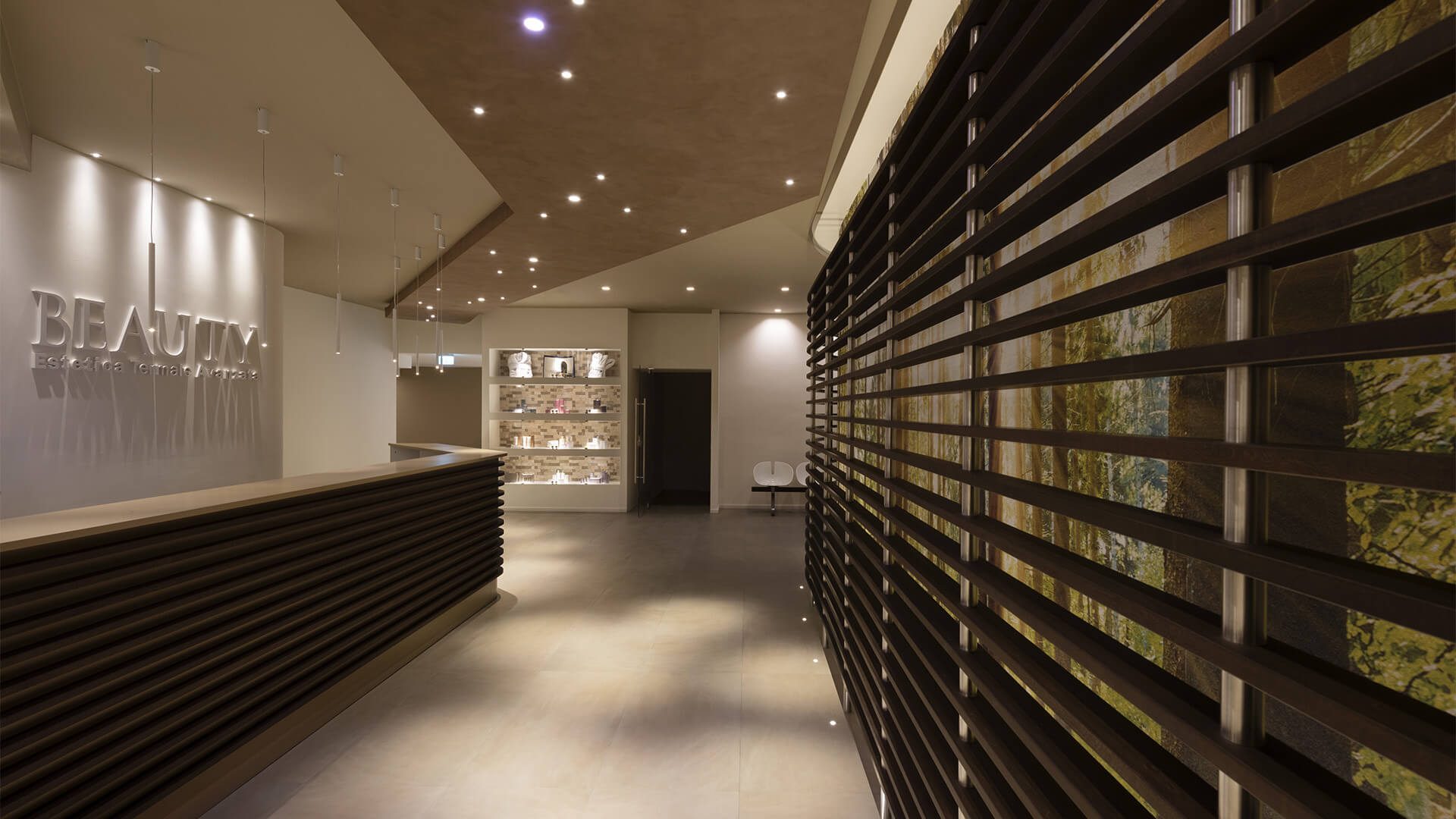
Choosing the appropriate lights for a spa is an important step in creating the right atmosphere and ensuring customer comfort.
We took this axiom into account when we worked on the lighting design of Terme Pompeo: the lights from 9010novantadieci were the final touch to complete the set-up of a pleasant and fulfilling environment for clients from the lighting point of view as well.
Lights are an important part of spa investments: from them comes the ability to generate a warm, relaxing atmosphere that will make clients feel comfortable and entice them to return more often.
Wellness center lights: how to choose the right ones
Opt for lights that can be adjusted according to the desired lighting level. This allows you to create different atmospheres during different stages of the day or for different treatments dispensed.
Each area of the facility needs an appropriate type of lighting. Consider the different areas of the spa, such as treatment areas, relaxation areas, and reception areas. Care should be taken not to implement too many lamps, which would end up stressing the client rather than working for his or her well-being; much better to focus on quality rather than quantity through judicious choices.
The color of the lights given off can also be important, depending on the effect you want to generate. For example, blue lights can evoke a feeling of calm, while pink lights can be relaxing and energizing. Warm light shades (such as yellow) are generally for relaxation and appropriate for a spa.
A good rule of thumb is to ensure that the style of lights is consistent with the decor and overall atmosphere of the spa. Lights should blend harmoniously with the décor elements and give those present an impression of pleasant welcome and care in every detail.
In relaxation areas, the light should be particularly soft and indirect: a warm light between 2200K and 3000K is suitable in massage areas to illuminate without glare. In areas deputed to beauty treatments we can opt for a light with a higher temperature, between 3000K and 4000K so as to ensure optimal visibility. Here we can opt for directional light sources with direct light from the narrow beam aperture.
How to illuminate the areas of a wellness center
In the massage areas, natural light is completely dimmed so that the client can get all the comfort he or she wants from privacy. Dimmable LED lights can be used to bring the lighting to the desired level.
Floor and table lamps are appropriate solutions for reaching focal points and providing more intimate lighting in relaxation areas. In showers and swimming pools, we can opt for RGB strips with a high IP rating to ensure maximum customer comfort.
In connecting areas such as corridors we can opt for brighter light to ensure the required focus. The general rule of thumb, however, is that the customer does not experience the change of brightness between one room and another as annoying.
For example, we can use spotlights to compensate for the differential in light output between one room and another.
The checkout at the entrance needs to be adequately lit to stimulate impulse purchases, so we can place spotlights in order to capture attention toward it and the products placed on the shelves.
Nor should we neglect the outdoor lighting of the wellness center, which is crucial to attract the attention of potential customers. Therefore, for the sign, we can opt for lights with neutral shades instead of warm and cold ones.
How to illuminate the walls of the wellness center
Add decorative lights along the walls to create a unique atmosphere. You can use artistic wall lamps or wall sconces with interesting designs that blend in with the spa décor. Bright-yellow or warm-white lights can create a welcoming and relaxing atmosphere. Where you can, resort to natural light from windows to create a sense of cohesion with the outdoors and increase the well-being of those present. Large windows or glass walls can help create an open and inviting atmosphere. To this end, avoid placing large furniture or bulky plants that risk hindering the spread of light.
Opt for a combination of ambient, decorative and functional lights. Ambient lights create a relaxing atmosphere, decorative lights add style and personality, and functional lights are needed for specific activities.
Through the judicious use of directional spotlights you can generate bewitching lighting effects, such as shadow and light effects, to give depth and interest to walls. Focus specific lighting specifically toward the details of the artwork and furniture you want to highlight, so as to enrich visitors' experience.
Banish the mundane! Use a mix of light sources at different levels to avoid flat lighting. Combine ceiling lights, wall sconces, and floor or table lamps to accentuate a visual depth.
LED spa lighting
LED lights are energy efficient and long-lasting. In addition, they can be dimmed to create the desired atmosphere. With dimmers, you can set the desired light level for each area in relation to each time of day.
LED strips are suitable for providing the lighting needed in the reception area to make it stand out prominently: we can place them along the counter and behind it to highlight it
Filtered, low-intensity LED light is ideal for making the customer feel relaxed and comfortable. Thanks to the dimmers, it will then be possible to turn it up when the customer has left to set up and clean the premises.
Use indirect lighting, such as LED strips hidden behind panels or furniture. This type of lighting reduces direct glare and contributes to a more relaxing atmosphere.
Use indirect lighting to create a soft, diffuse effect on walls. You can hide LED strips behind panels, picture frames, or shelves for soft, comfortable lighting.
Need suggestions on the right kind of lights for your spa? Our experts are ready to help you